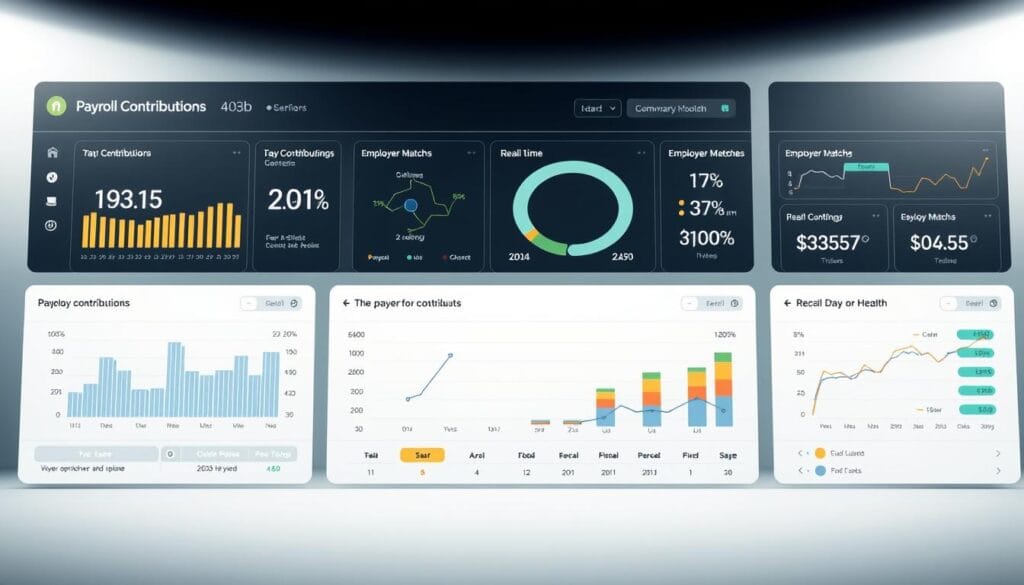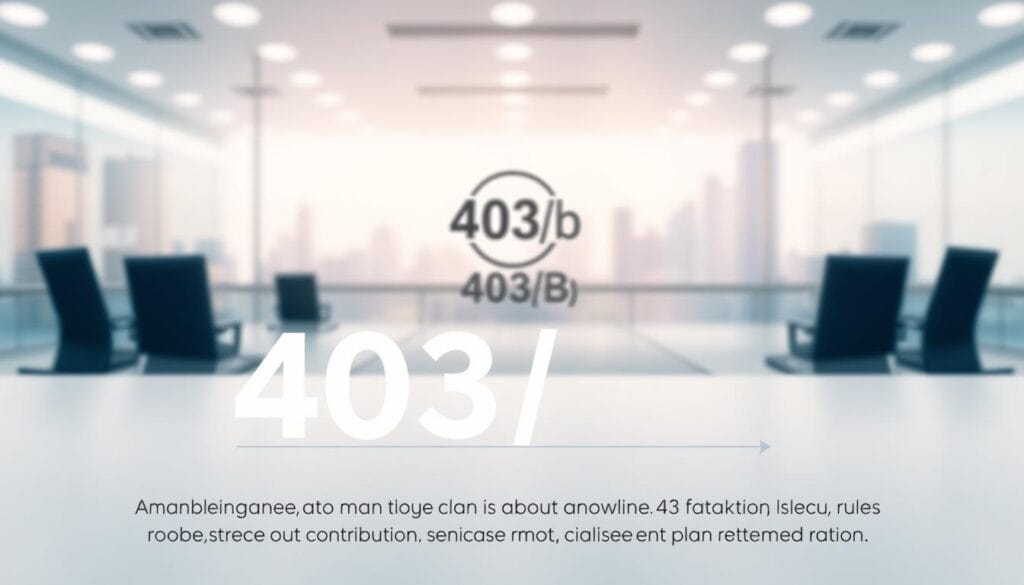Surprising fact: many public school and nonprofit workers can defer more than $23,000 a year into a workplace account, giving a large boost to long-term savings potential.
This guide explains how a 403(b) works for employees at schools, charities, and faith-based groups. It automates payroll deferrals, and can include employer matches, mutual funds, and annuities to grow money over time.
We will cover eligibility, contribution limits for 2024–2025, traditional vs Roth tax rules, withdrawals, loans, RMDs, and simple administration tips. Reviewing your employer’s match and investment lineup can change how fast savings grow.
Read on with recent numbers and practical steps so you can gather statements, understand tax choices, and act with confidence.
Key Takeaways
- 403(b) accounts automate payroll contributions for many public and nonprofit employees.
- They offer tax advantages and possible employer matches that can boost savings.
- 2024–2025 limits and special catch-up rules affect how much older workers can add.
- Investment choices include mutual funds and annuities; risk should shift as time nears.
- Gather plan documents and statements now to apply this information quickly.
- For a quick comparison with similar options, see this 401(k) overview.
What is a 403(b) and who is eligible?

If you work for a public school, university, or a 501(c)(3), your employer may offer a tax-advantaged account that takes contributions right from your salary. That setup makes saving automatic and often pairs payroll deferrals with institutional investments.
Employees at public schools, 501(c)(3) charities, and certain faith-based organizations
Public school districts, hospitals, colleges, nonprofit charities, and some faith-based employers typically provide access. Eligibility depends on your employer’s benefits and the specific enrollment rules they set.
How it compares to a 401(k) and IRAs
At a high level, this account channels salary deferrals into mutual funds or annuities and may include employer matches. It offers tax advantages similar to a 401(k), while IRAs depend on individual income and have different annual limits.
- Key benefits: employer matches, automated payroll, institutional funds, and online account information.
- Some employer programs allow loans and hardship withdrawals; IRAs do not offer loans.
- Years of service can matter for special catch-ups and higher contribution options later on.
| Feature | Workplace account | IRA |
|---|---|---|
| How contributions enter | Payroll deferral | Direct deposit or transfer |
| Employer match | Possible | None |
| Loan option | Sometimes | No |
Compare fees, investment menus, and flexibility before deciding where to focus savings. For IRA choices, see this IRA options for beginners.
How a 403(b) works day to day

, With a payroll election you set a portion of each paycheck to go into your employer account.
Choose pre-tax or Roth deductions, pick an amount, and verify the deduction appears on your paystub and in the account each pay period.
Payroll deferrals and confirmation
Start small if needed. Log into the employer portal, set the percentage or flat dollars, and confirm the contribution posts.
Automated rebalancing and rate changes keep investments aligned with your time horizon.
Capturing employer contributions
Many employers match a portion of employee contributions. Structure your elections to capture the full match over the year so you don’t leave free money on the table.
Investment options the plan allows
Menus usually include mutual funds, target-date funds, and annuities. Review fees, update beneficiaries, enable auto-escalation, and check investment choices annually.
- Confirm contributions each pay period.
- Coordinate amounts with monthly cash flow.
- Understand a loan feature before borrowing—it can interrupt compounding.
For related individual account options, see top Roth IRA providers when comparing choices.
Tax treatment explained: traditional vs Roth 403(b)

How you fund your workplace account affects taxable income today and the tax hit on future withdrawals.
Pre-tax contributions and tax-deferred growth
Traditional: Contributions are made pre-tax, which lowers current taxable income. Earnings grow tax-deferred while invested.
Each distribution you take in later years is taxed as ordinary income. This can be useful if your income is lower in retirement than now.
Roth contributions and qualified withdrawals
Roth: You contribute after-tax dollars. If you meet the 5-year rule and are 59½ (or disabled or deceased), qualified distributions of contributions and earnings are federal tax-free.
Some employers let you split contributions between both options in the same year. That gives tax diversification and flexibility over time.
- Example: A worker who expects lower income later may prefer pre-tax to defer taxes now; someone who expects higher income later may favor Roth.
- Keep records so the account’s 5-year clock and basis are clear in your employer portal.
- Early withdrawals can trigger taxes and penalties regardless of bucket; check withdrawal rules before acting.
Tip: Review marginal tax rates, Social Security taxation, and expected income sources. For guidance on distribution choices, see this distribution comparison.
403b retirement plan basics: annual limits, catch-ups, and special rules

Annual caps, age-based add-ons, and service exceptions shape how much an employee may defer from each paycheck.
Base annual limits and age-based catch-ups
Base limit: Employees under 50 can contribute up to $23,000 in 2024 and $23,500 in 2025. Set a salary percentage that keeps contributions inside the limit for the whole year.
Age 50+ catch-up: Those 50 or older may add $7,500 in both 2024 and 2025. In 2025, workers aged 60–63 may be able to make an additional catch-up of up to $11,250, depending on whether the employer permits it.
15-year service catch-up and combined limits
The 15-year service provision can allow up to $3,000 extra per year, with a $15,000 lifetime cap. Eligibility depends on years of service and prior amounts contributed with the same employer. This option is not available if you’ve already contributed $75,000 or more with that employer over the years.
| Item | 2024 | 2025 |
|---|---|---|
| Base elective deferral limit | $23,000 | $23,500 |
| Age 50+ catch-up | $7,500 | $7,500 |
| Combined employer + employee cap | $69,000 | $70,000 |
| Additional 60–63 catch-up (if allowed) | N/A | Up to $11,250 |
Avoiding and correcting excess contributions
Monitor payroll and coordinate midyear changes to avoid excess amounts. Both pre-tax and Roth contributions count toward the annual limit.
If you overcontribute, contact the employer promptly. The plan can remove the excess and earnings by the tax filing deadline so you won’t have to pay taxes twice on the same dollars.
- Confirm whether your employer allows the 15-year service catch-up; not all plans offer it.
- Set a calendar reminder to reassess contribution levels each year and after raises.
- Remember: loans are common in many plans, but borrowing can slow progress when making catch-up contributions.
Withdrawals, penalties, and plan loans

Taking money from your workplace account requires careful timing to avoid extra tax and lost growth. Know the rules before you request a withdrawal or seek a loan.
When withdrawals are penalty-free and the 10% early penalty
Generally, penalty-free withdrawals begin at age 59½. Earlier distributions usually trigger a 10% early withdrawal penalty plus ordinary tax on the taxable amount.
Some exceptions exist (disability, certain separations from service, or specific hardship rules). Confirm your employer’s plan for precise eligibility before you act.
How a loan works and the compounding trade-off
Many workplace accounts allow a loan. You borrow against your balance, repay with interest, and the borrowed funds are not invested during the loan.
That interruption reduces potential earnings and long-term growth. Weigh the short-term benefit of money now against lost funds and future compounding.
Job changes, repayment deadlines, and tax risk
If employment ends, outstanding loans often become due by the tax filing year deadline. Unpaid balances get treated as a taxable distribution and may require you to pay taxes and a 10% penalty if under 59½.
- Review the plan loan policy: max amount and repayment terms.
- Keep documentation of any withdrawal or loan for accurate tax reporting.
- Consider an emergency fund to avoid borrowing late in your career.
Tip: Talk with the plan administrator and a tax professional before borrowing or withdrawing to protect your long-term savings and tax position.
Required minimum distributions for 403(b) accounts

Required minimum distributions set firm dates for taking taxable withdrawals from your workplace account once you reach a specified age. Follow the schedule so you avoid steep excise taxes and filing headaches.
RMD starting age, still-working exception, and timing rules
Starting age: RMDs typically begin at age 73, though some rules extend the effective age to 75 for certain older provisions.
Still working? If you remain employed by the employer that sponsors the plan, you can often delay RMDs from that specific plan until you retire. Confirm that exception with your employer’s administrator.
Timing: The first RMD is due by April 1 of the year after you reach the RMD age (or the year after retirement if using the still-working exception). Each subsequent RMD is due by December 31 of each year.
Special pre-1987 treatment and missed RMD penalties
If pre-1987 contributions are separately tracked by your employer, those contributions can be excluded from required distributions until the later of age 75 or April 1 after retirement. Note: earnings on those pre-1987 amounts count in RMD calculations immediately.
The plan calculates each year’s amount using IRS life-expectancy tables and the prior year-end balance. Accurate records and statements matter for precise amounts and correct tax reporting.
| Topic | What to check | Deadline |
|---|---|---|
| First RMD | Confirm starting age and employer exception | April 1 after the year you reach the RMD age |
| Subsequent RMDs | Use prior year-end balance & IRS tables | December 31 each year |
| Pre-1987 contributions | Verify separate accounting with employer | Later of age 75 or April 1 after retirement |
| Missed RMD penalty | Shortfall may face 25% excise tax (reducible) | Correct within two years to reduce to 10% |
- Review your plan information annually, especially if you hold multiple accounts.
- Coordinate distributions with other income to manage taxes and cash flow.
- Keep yearly statements and distribution records to support corrections if needed.
For more context on new account options and how distributions fit into a broader strategy, see this overview of new savings accounts.
Strategies for seniors to maximize retirement savings
Small steps over time can add meaningful dollars to your account. Start by capturing the full employer match each pay period so you do not leave free money on the table.
Prioritizing employer match and aligning contributions with income
Set contributions to secure 100% of employer contributions. If cash flow is tight, use automatic escalation: increase your rate quarterly by 1% until you hit your target.
Coordinating catch-up contributions with investment choices and risk
Workers 50+ (and those 60–63 with the additional catch-up) should coordinate catch-up contribution amounts with asset allocation. Make additional catch-up contributions when pay is steady, and dial down equity risk as the time to full withdrawal nears.
- Glide path example: move gradually from 70% equities / 30% bonds to 40% equities / 60% bonds over five years.
- Rebalance at least annually to keep risk aligned with goals.
- Keep 1–2 years of expected withdrawals in conservative funds to avoid selling during market lows.
Tax-aware placement matters: allocate tax-inefficient investments to tax-deferred accounts and tax-efficient funds to taxable or Roth accounts. Stress-test your savings for longevity, health costs, and inflation.
For coordinating income sources and claiming timing strategies, see this guide to Social Security timing.
Plan administration and compliance you should know
IRS remedial windows give sponsors a clear path to correct document defects without risking qualified status.
Existing plans that adopted written documents by December 31, 2009 can fix form defects retroactive to January 1, 2010 if they timely move to a pre-approved program with an IRS opinion letter.
Employers that started a program on or after January 1, 2010 can also rely on retroactive corrections when they adopt pre-approved documents and cure defects back to the effective date.
- Revenue Procedure 2019-39 established recurring remedial amendment cycles so sponsors can update documents on a set schedule.
- Keep sponsor documents current, make timely amendments, and share accurate information with participants each year.
- Document updates can change how limits, service definitions, and timing apply, which affects participant money and tax outcomes.
Participants should review notices and summaries annually and ask HR or the plan administrator for official documents when something looks off. Good governance lowers operational risk and helps protect everyone’s savings.
Conclusion
Before you act, confirm limits, employer features, and timing with your administrator. Verify 2024–2025 amounts, catch-ups available at age 50+, and the extra 60–63 option if your employer allows it.
Capture any employer match first, then use catch-up contributions to boost savings in the final working years.
Coordinate withdrawals and RMD timing to manage taxes and cash flow, and keep enough liquidity so you avoid forced withdrawals at a market low.
Keep statements, notices, and beneficiary info up to date. Log in, confirm your contribution rate and investment mix, and schedule a yearly check-up with HR or a fiduciary tax professional.

